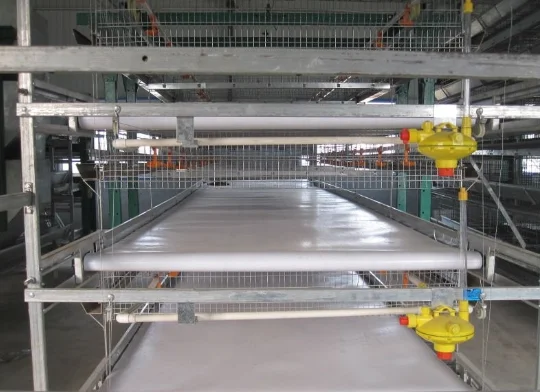Innovative Solutions for Sustainable Large Scale Poultry Housing and Management Practices
Oct . 13, 2024 07:24 Back to list
Innovative Solutions for Sustainable Large Scale Poultry Housing and Management Practices
Large-Scale Poultry Housing Innovations and Best Practices
The global demand for poultry products continues to soar, driving the need for efficient and sustainable poultry housing systems. Large-scale poultry housing has transformed the poultry industry, embracing innovations that ensure productivity, animal welfare, and environmental sustainability. This article explores the key aspects of large-scale poultry housing, covering design, management practices, and the importance of biosecurity.
Design Considerations
The design of large-scale poultry housing plays a crucial role in maximizing production while ensuring the welfare of the birds. Modern poultry houses are typically constructed with materials that promote ventilation, insulation, and ease of cleaning. These structures are designed to accommodate high stocking densities while allowing for adequate space for each bird, which is critical for their health and productivity.
A common design includes open-sided houses that utilize natural ventilation to regulate temperature and humidity levels. Proper insulation is necessary to maintain a stable environment, minimizing heat stress during warmer months and preventing cold stress in winter. Moreover, the orientation of the building can affect solar gain and airflow, making it essential to consider local climate conditions during the planning stage.
Innovative housing solutions, such as enriched cages for layer hens or free-range systems for broilers, have been developed to provide more space and improve the overall quality of life for the birds. These alternatives prioritize animal welfare while still being capable of supporting large-scale operations.
Management Practices
Effective management practices are vital in large-scale poultry housing to ensure the health and productivity of the flock. One fundamental aspect is the application of optimal feeding and watering systems. Automated feeding systems deliver precise amounts of feed at scheduled intervals, enhancing growth rates and minimizing waste. Similar advancements in watering systems ensure that birds have constant access to fresh water, which is critical for their health.
large scale poultry housing

Furthermore, regular monitoring of environmental conditions—such as temperature, humidity, and air quality—is essential. Utilizing climate control systems helps maintain optimal living conditions for the birds throughout their lifecycle. Data-driven technologies, such as sensors and IoT devices, are increasingly being employed to gather real-time information and provide insights for better management decisions.
Biosecurity is another critical management practice in large-scale poultry housing. The introduction of disease can have devastating effects on poultry populations and subsequent farming operations. Therefore, strict biosecurity measures—such as limiting access to poultry houses, regular health checks, and effective pest control—are essential. Training staff on biosecurity protocols is equally important to ensure that everyone involved understands their role in protecting the flock.
Sustainability and Environmental Considerations
Sustainable practices in large-scale poultry housing not only contribute to better animal welfare but also address environmental concerns. The poultry industry is a significant contributor to greenhouse gas emissions; therefore, innovations aimed at reducing the environmental impact are becoming increasingly important.
One approach is the implementation of waste management systems that convert poultry litter into valuable byproducts, such as organic fertilizers. These systems not only minimize environmental pollution but also provide an additional revenue stream for poultry farmers. Additionally, using renewable energy sources, such as solar panels or wind turbines, can help reduce the carbon footprint of poultry operations.
Water management is another area where sustainability can be improved. Technologies that recycle and reuse water within the housing system can lead to significant reductions in water usage. Implementing rainwater harvesting systems can also supplement water sources, particularly in areas prone to drought.
Conclusion
Large-scale poultry housing presents both challenges and opportunities for poultry producers. By focusing on innovative designs, effective management practices, and sustainability, poultry operations can not only meet the growing demand for poultry products but also do so in a manner that prioritizes animal welfare and reduces environmental impact. These advancements demonstrate that it is possible to achieve high productivity levels while also being responsible stewards of the industry. As technology continues to evolve, the future of large-scale poultry housing looks promising, with the potential for even greater efficiencies and sustainability in the years to come.
-
Automatic Feeding Line System-Pan Feeder Nipple Drinker|Anping County Yize Metal Products Co., Ltd.
NewsJul.29,2025
-
Hot Sale 24 & 18 Door Rabbit Cages - Premium Breeding Solutions
NewsJul.25,2025
-
Automatic Feeding Line System Pan Feeder Nipple Drinker - Anping County Yize Metal Products Co., Ltd.
NewsJul.21,2025
-
Automatic Feeding Line System Pan Feeder Nipple Drinker - Anping County Yize Metal Products Co., Ltd.
NewsJul.21,2025
-
Automatic Feeding Line System - Anping Yize | Precision & Nipple
NewsJul.21,2025
-
Automatic Feeding Line System - Anping Yize | Precision & Nipple
NewsJul.21,2025






